Explore the profound world of Vincent Van Gogh through his inspirational quotes on art, life, and love. This article delves into ten powerful Vincent Van Gogh quotes that reveal the depth of his emotions and philosophical insights. Discover how his words continue to inspire creativity and resilience, bridging the gap between 19th-century artistry and modern-day challenges. Whether it’s his views on nature, the power of dreams, or the complexities of human emotions, each quote offers a timeless reflection on the human condition and artistic endeavor.
- Introduction
- Quote 1: Van Gogh on The Dream of Painting
- Quote 2: About Life and Starting New
- Quote 3: Embracing Imperfections
- Quote 4: Finding Beauty Everywhere
- Quote 5: The Colors of Emotions
- Quote 6: Overcoming Adversity
- Quote 7: The Value of Hardship
- Quote 8: On Being Misunderstood
- Quote 9: Persistence in Passion
- Quote 10: The Solace of Art
- Conclusion
Introduction
Vincent Van Gogh, a titan of post-impressionist art, has long captivated the world not only with his vivid canvases but also through his poignant words. Known for his profound impact on the trajectory of modern art, Van Gogh’s paintings—characterized by swirling brushstrokes, bold, emotive colors, and dynamic textures—invite viewers to peer deeper into the emotional landscapes he portrayed. However, beyond the lush fields of “Wheatfield with Crows” or the swirling heavens of “Starry Night,” Van Gogh’s extensive letters and written reflections reveal a man grappling with his own psyche and the nature of creativity.
His correspondence, particularly those to his beloved brother Theo, unveil a man of deep philosophical insight and emotional intensity. These letters, laden with musings about life, art, and existence, offer a more comprehensive understanding of Van Gogh as an artist and a thinker. Through his words, we see Van Gogh’s ceaseless quest to convey not just the appearance of a landscape or a figure, but the spirit and emotion it evoked within him.
This article aims to delve into ten of Van Gogh’s most inspiring quotes. Each quote serves as a beacon to those who seek to understand more about this complex artist’s views on art, life, and the creative process. For artists and creatives in the modern world, these quotes offer timeless guidance and reflection, bridging the gap between the 19th-century brushstrokes of a Dutch master and the contemporary pursuit of meaningful artistry. Join us as we explore how Van Gogh’s spirited words continue to invigorate the creative spirit across generations.
Quote 1: Van Gogh on The Dream of Painting
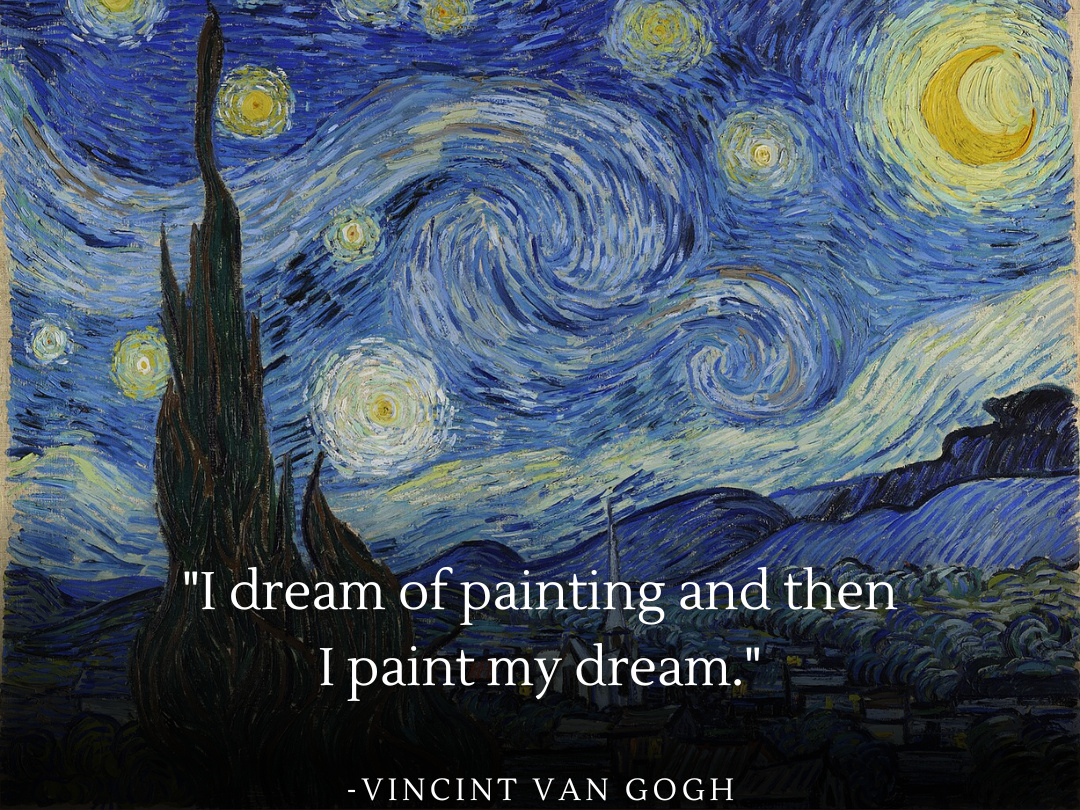
“I dream of painting and then I paint my dream.”
This quote beautifully encapsulates Vincent Van Gogh’s artistic process, highlighting his unique ability to transform vivid mental images into physical art. Unlike artists who simply replicate what they see, Van Gogh ventured beyond mere representation. His approach was deeply imaginative, using dreams and visions as the foundation for his work. This method allowed him to explore beyond the observable, infusing his paintings with emotional depth and personal resonance. The result was not just a depiction of the world but an expressive, emotional response to it. In these words, Van Gogh reveals the essence of his creativity: art as the transformation of the invisible dreams into visible expressions, a testament to the power of imagination in shaping art.
Quote 2: About Life and Starting New
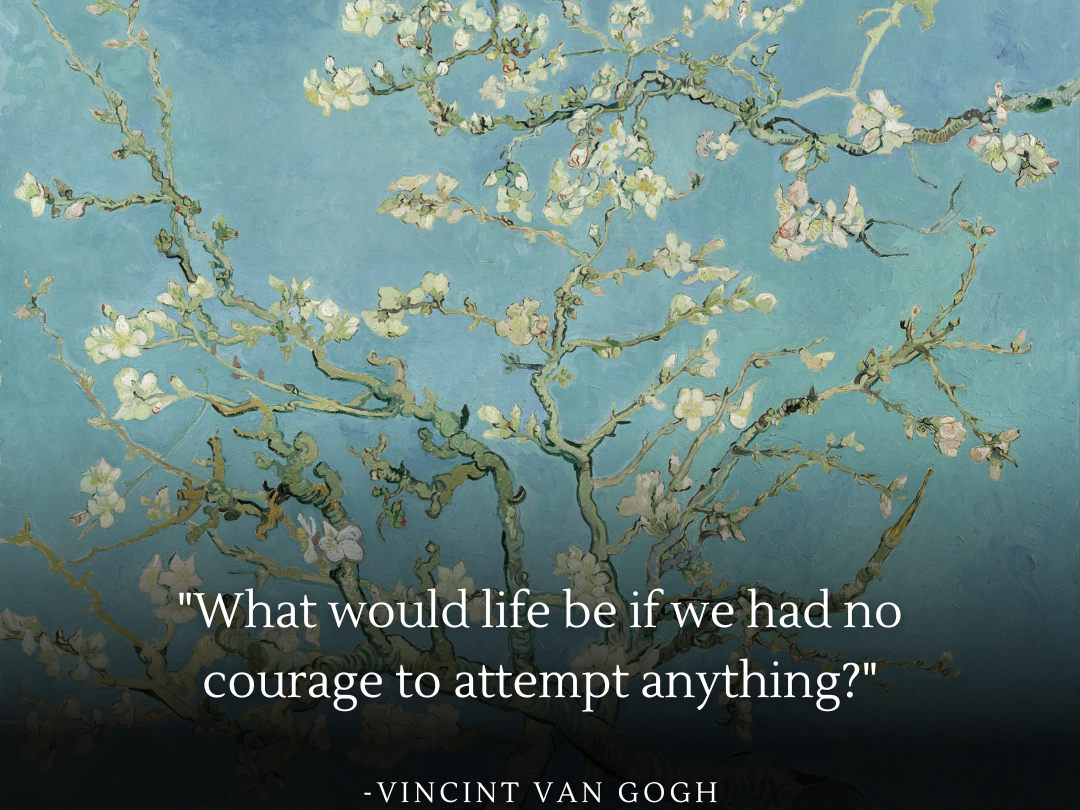
“What would life be if we had no courage to attempt anything?”
Vincent Van Gogh’s question reflects a core belief in the transformative power of courage, especially in the realm of creativity. His own life, marked by bold transitions and a pioneering spirit, exemplifies the necessity of bravery in the pursuit of artistic innovation. This quote encourages us to confront the fear of the unknown and the comfort of the familiar. Van Gogh’s adventurous spirit reminds us that the act of creating often requires us to take risks and embrace new challenges. For anyone engaged in creative endeavors, this message serves as a rallying cry to push beyond limitations and explore new horizons, affirming that the essence of a fulfilling life is found not in safety, but in the brave pursuit of new experiences.
Quote 3: Embracing Imperfections
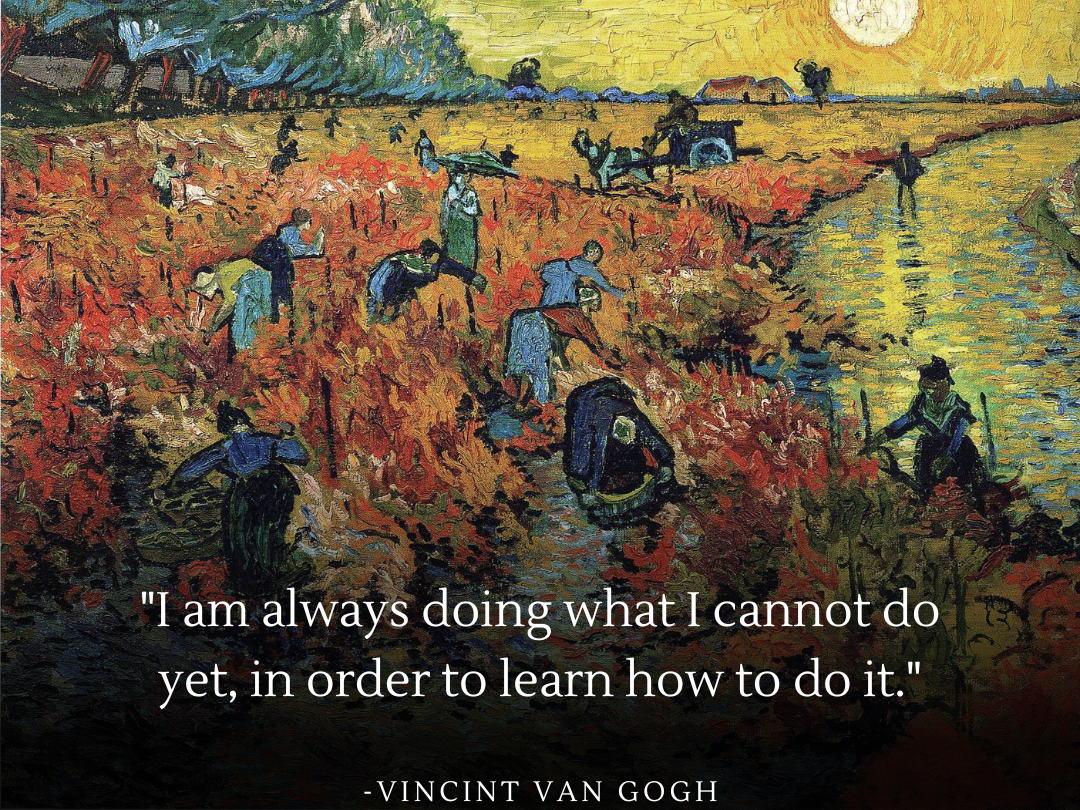
“I am always doing what I cannot do yet, in order to learn how to do it.”
This quote from Vincent Van Gogh underscores a fundamental truth about personal and artistic growth: the necessity of embracing challenges and imperfections. Van Gogh’s willingness to engage with techniques and subjects beyond his immediate skill set illustrates a key aspect of his approach to art and life—continuous learning through doing. His words encourage us to step out of our comfort zones and tackle tasks that we might not initially feel competent at. This mindset not only fosters resilience and adaptability but also drives innovation and creativity. By constantly pushing our boundaries and accepting that imperfection is part of the process, we open ourselves up to new possibilities and deeper understandings, both in our art and in our lives.
Quote 4: Finding Beauty Everywhere
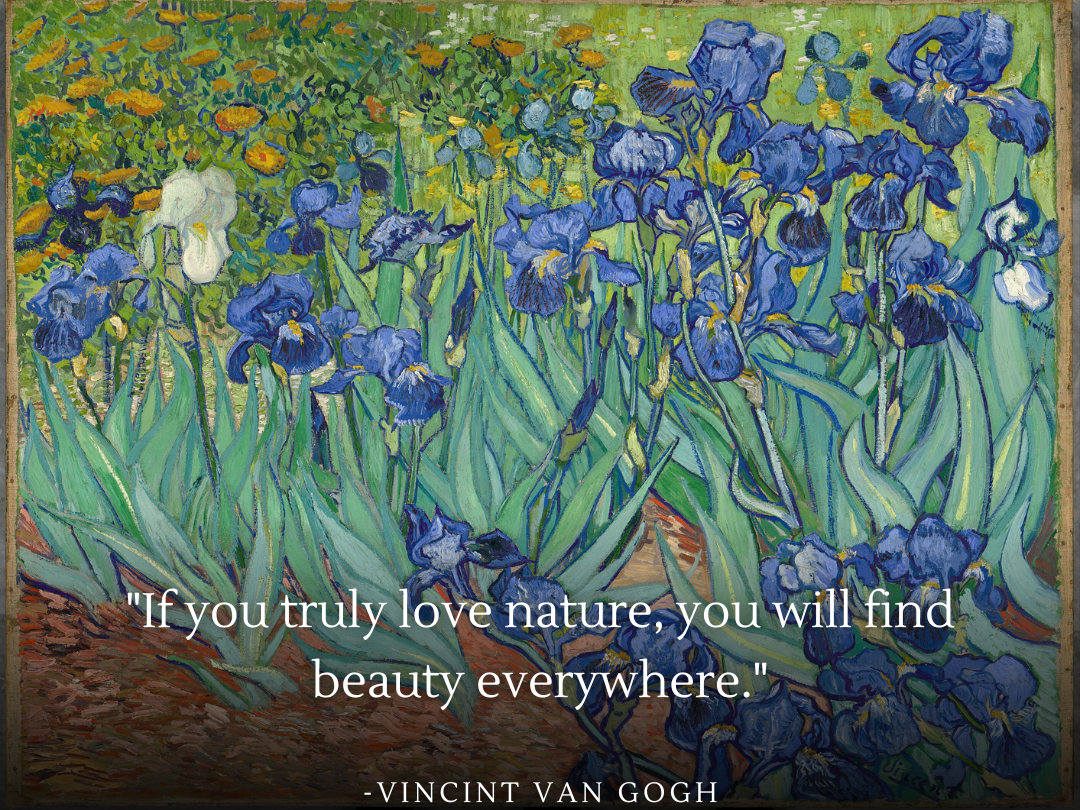
“If you truly love nature, you will find beauty everywhere.”
Vincent Van Gogh’s profound connection to nature is vividly portrayed in his art, where even the simplest landscape pulses with life and color. This quote reflects his belief that beauty isn’t just found in traditionally picturesque settings but is pervasive, waiting to be noticed by those who look with affection and attention. Van Gogh’s perspective invites us to explore our environments with a renewed sense of wonder, suggesting that inspiration can be found in the most ordinary places. For creatives, this means the potential for inspiration is limitless—it surrounds us, infused in the fabric of everyday life, accessible through the simple act of appreciating nature’s presence everywhere we go.
Quote 5: The Colors of Emotions
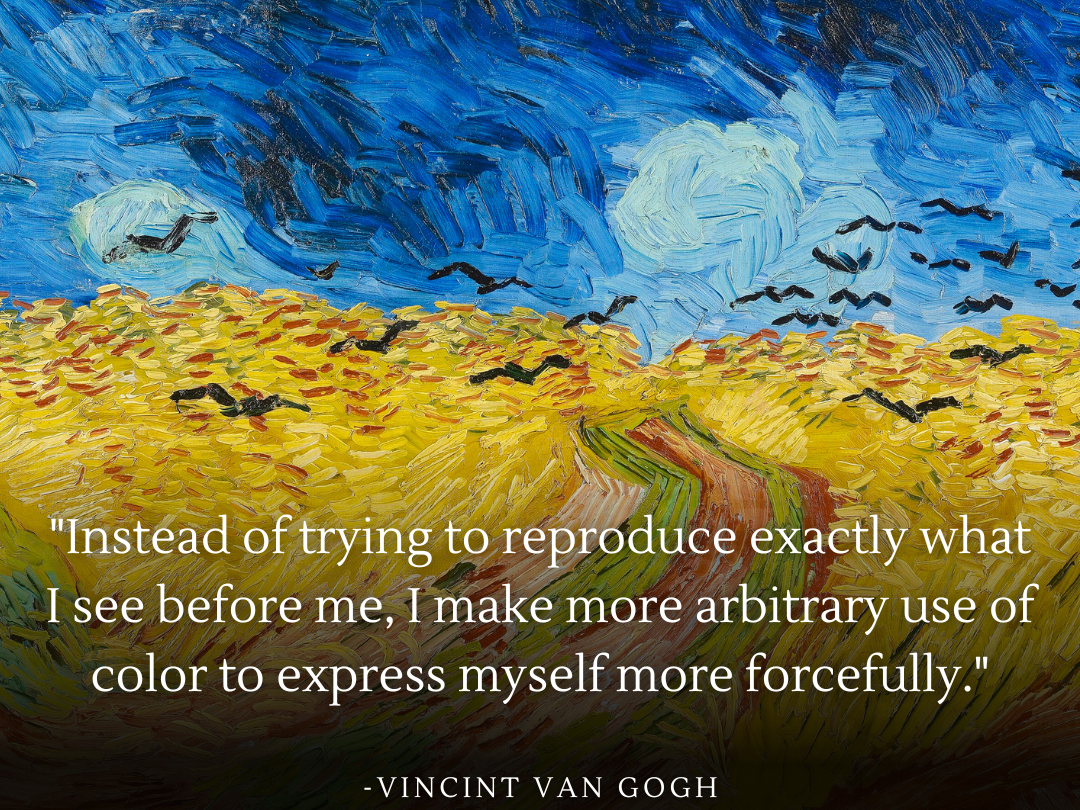
“Instead of trying to reproduce exactly what I see before me, I make more arbitrary use of color to express myself more forcefully.”
Vincent Van Gogh’s innovative approach to color dramatically shifted the course of modern art. This quote highlights his departure from strict realism in favor of an expressive, emotional use of color. Van Gogh did not simply paint what he saw; instead, he used colors to convey his feelings and emotional responses to the world around him. This technique allowed him to capture not just the appearance of a scene but the emotional truth he perceived within it. His bold use of color to express mood and atmosphere has inspired countless artists to explore more personal and subjective representations in their own work, influencing the development of expressionism and other modern art movements.
Quote 6: Overcoming Adversity
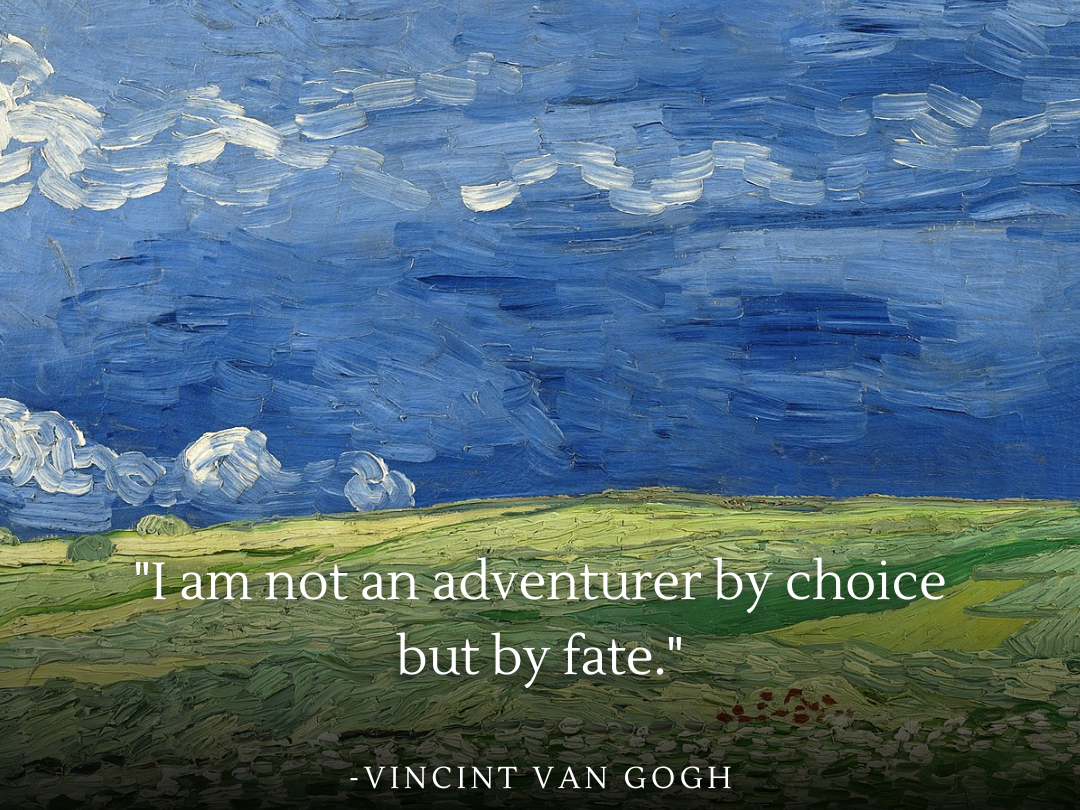
“I am not an adventurer by choice but by fate.”
This poignant reflection from Vincent Van Gogh gives us insight into his stoic acceptance of the numerous challenges that beset his personal and professional life. Van Gogh’s journey was fraught with mental health struggles, financial instability, and social rejection, yet he continued to produce groundbreaking art that profoundly affected the future of painting. This quote underscores his resilience and the unchosen path he walked as an artist, suggesting that sometimes the difficulties we encounter are not obstacles but essential parts of our destiny. It inspires us to persevere through adversity, embracing the role of the “adventurer” not by choice but as a calling that may lead to unexpected growth and profound creative contributions.
Quote 7: The Value of Hardship
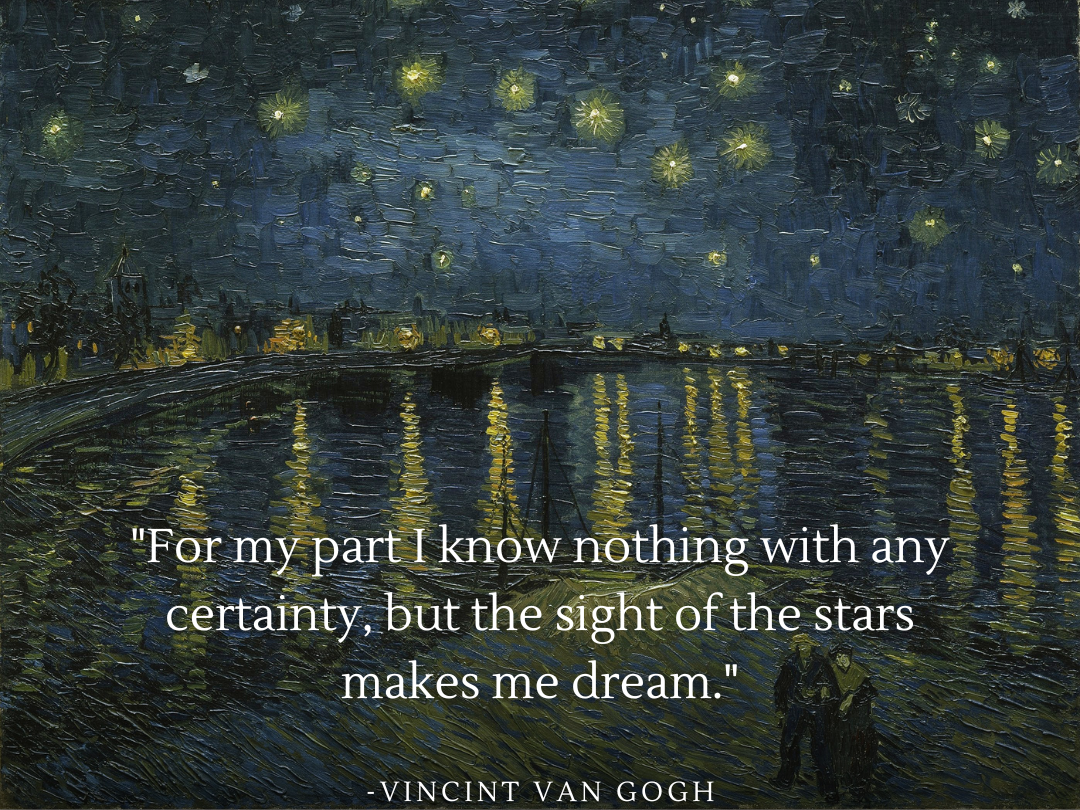
“For my part I know nothing with any certainty, but the sight of the stars makes me dream.”
Vincent Van Gogh’s reflections on the unknown and his experience of hardship are poignantly captured in this quote. Despite facing significant personal and professional uncertainty, Van Gogh found solace and inspiration in the night sky, as famously depicted in his masterpiece “Starry Night.” This work, with its turbulent, emotional representation of the heavens, suggests that adversity and uncertainty are not just challenges to be overcome but can also be powerful sources of inspiration. Van Gogh’s ability to dream amidst difficulties highlights a vital message for creatives: that the times of greatest challenge can also be oments of intense creativity and vision, urging us to look beyond the immediate troubles and find beauty and possibility in the wider universe.
Quote 8: On Being Misunderstood
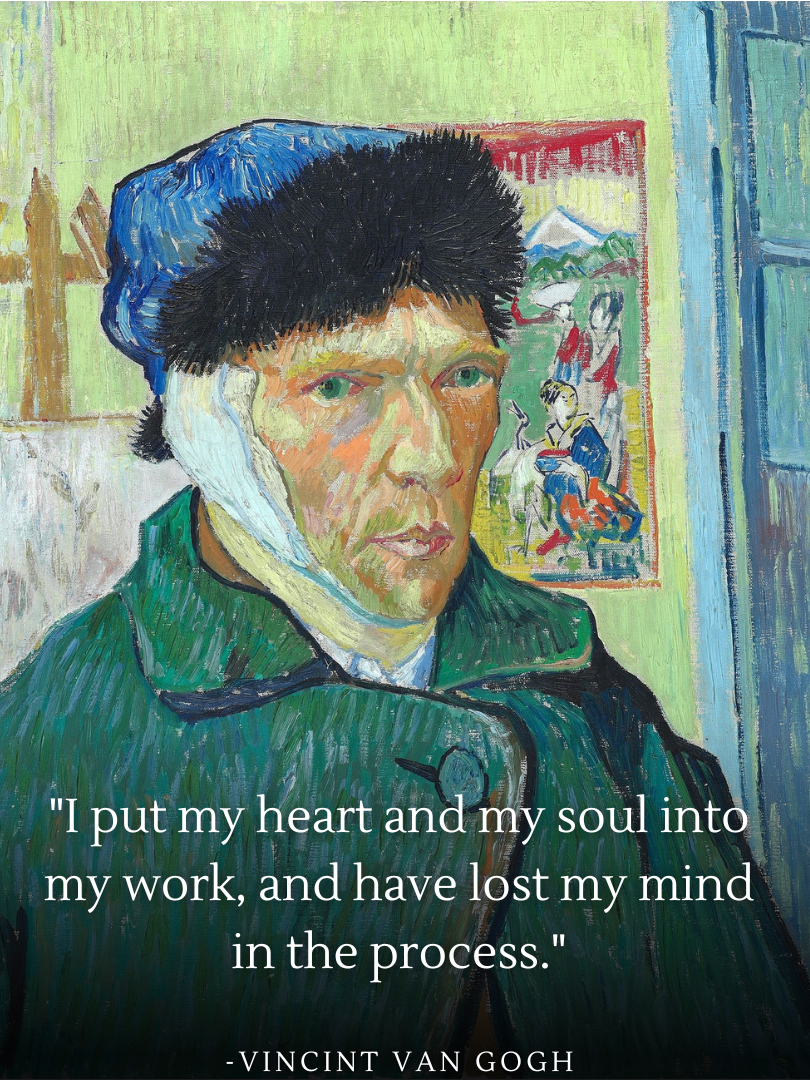
“I put my heart and my soul into my work, and have lost my mind in the process.”
Vincent Van Gogh’s words poignantly address the deep emotional investment and the personal toll that often accompany the creative process. This quote reflects the intensity with which Van Gogh approached his art, often sacrificing his mental and emotional well-being in his pursuit of artistic expression. His experiences underscore a common reality many artists face: the profound art they create can sometimes come at a significant personal cost. This message resonates with creatives who might feel misunderstood or isolated by their dedication to their craft, offering them a sense of solidarity. It also encourages a broader appreciation of the sacrifices artists make to enrich cultural landscapes, highlighting the often-overlooked emotional depth that underpins significant creative achievements.
Quote 9: Persistence in Passion
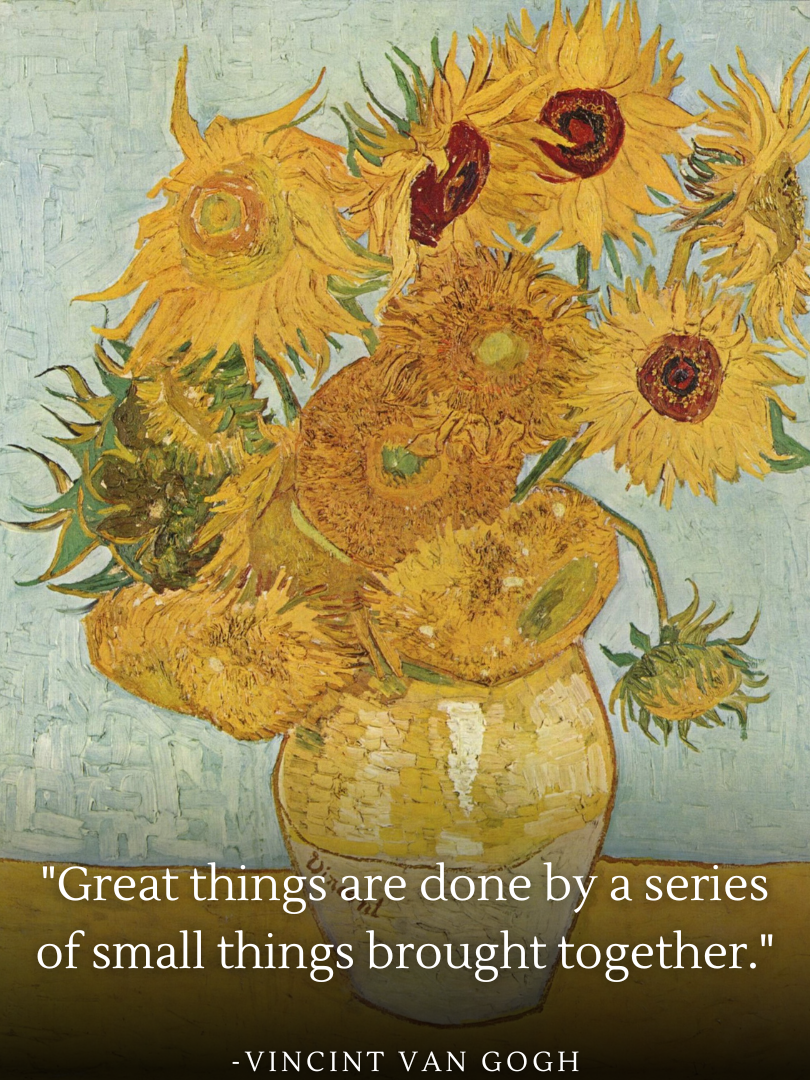
“Great things are done by a series of small things brought together.”
Vincent Van Gogh’s insight into the creative process reveals an essential truth about art and achievement: it is the accumulation of small, often mundane efforts that leads to greatness. This quote encourages artists and creatives to recognize the value of persistence and patience, emphasizing that monumental works are not created overnight but are instead the result of continuous, dedicated effort. Van Gogh himself often worked under challenging conditions, yet his relentless application to his craft allowed him to develop a body of work that would later be celebrated worldwide. This perspective is a powerful reminder that every small stroke, every minute of practice, and every single day of work contributes to the larger canvas of one’s life and career, building gradually into something truly significant.
Quote 10: The Solace of Art
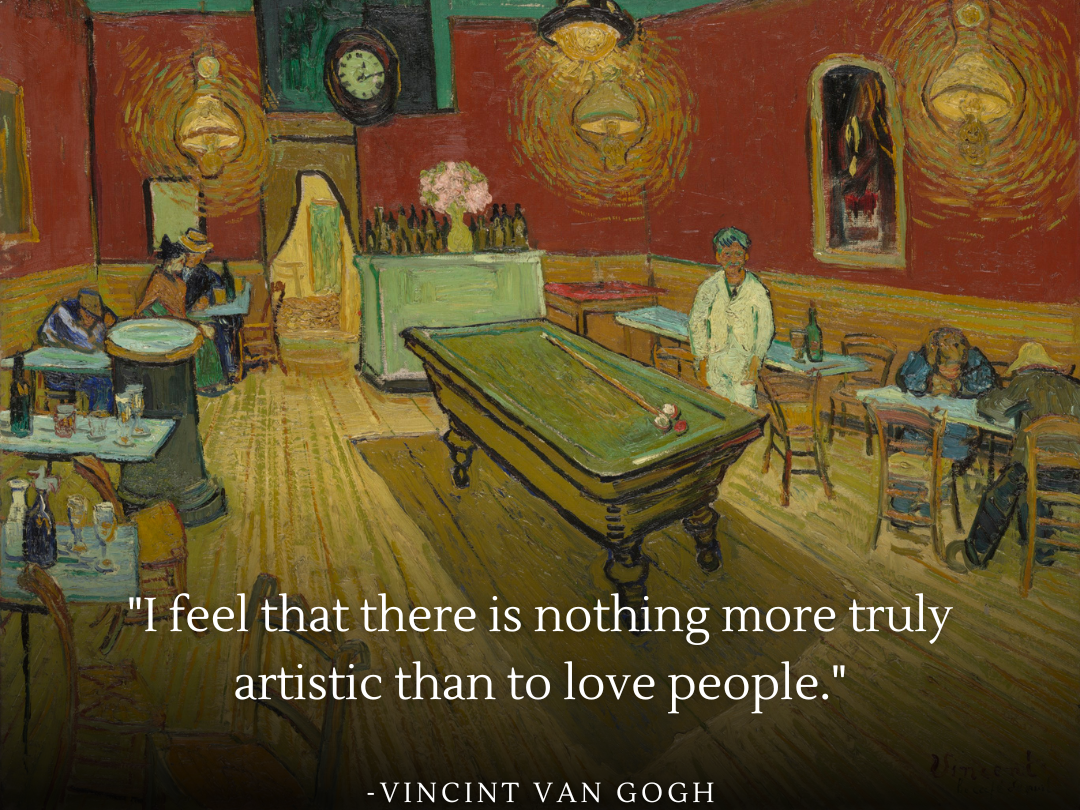
“I feel that there is nothing more truly artistic than to love people.”
In this profound statement, Vincent Van Gogh highlights the intrinsic connection between art and humanity. This quote reveals a deeply humanistic side of the artist, emphasizing that the essence of art transcends traditional mediums and finds its truest expression in love and empathy towards others. Van Gogh’s own artworks, which often depict ordinary people and everyday scenes, reflect his commitment to portraying human experiences with sincerity and compassion. By suggesting that loving people is the highest form of art, Van Gogh invites us to consider how empathy and understanding can enhance artistic expression, deepening its impact and making it more relatable. This perspective encourages artists to look beyond the surface of their subjects and to engage with the human condition in a way that is both profound and transformative.
Conclusion
Vincent Van Gogh’s words, like his paintings, continue to captivate and inspire long after his time. Each of the quotes explored in this article offers unique insights into his creative philosophy, personal struggles, and the universal truths of artistic endeavor. From embracing imperfections and finding beauty in the everyday to the emotional sacrifices inherent in true creative expression, Van Gogh’s thoughts resonate deeply with anyone engaged in creative work today.
His reflections remind us that art is not just about technique or skill but about passion, persistence, and the human experience. Whether it’s seeing the grandeur in small things, persisting through hardship, or expressing love and empathy, Van Gogh teaches us that these elements are essential in making meaningful art. His ability to articulate these complex, often painful human truths in both his visual and verbal expressions makes his work timeless and incredibly relevant to our current artistic and cultural landscape.
As we reflect on these ten powerful quotes, consider which ones strike a chord with your own experiences. Which quote resonates most deeply with your personal creative journey? Perhaps it’s the courage to start anew, the commitment to express your deepest emotions through color, or the recognition of love as the highest art form. Let Van Gogh’s words be a source of inspiration and a reminder of the profound connection between life’s challenges and its beauties, urging you to paint not just what you see, but what you feel, dream, and ultimately, what you strive to be.
For more insights into how iconic artists view their craft, explore our article on “10 Salvador Dalí Quotes That Will Change Your Perspective on Art” here, which delves into the surrealist master’s unique perspective on art and life.

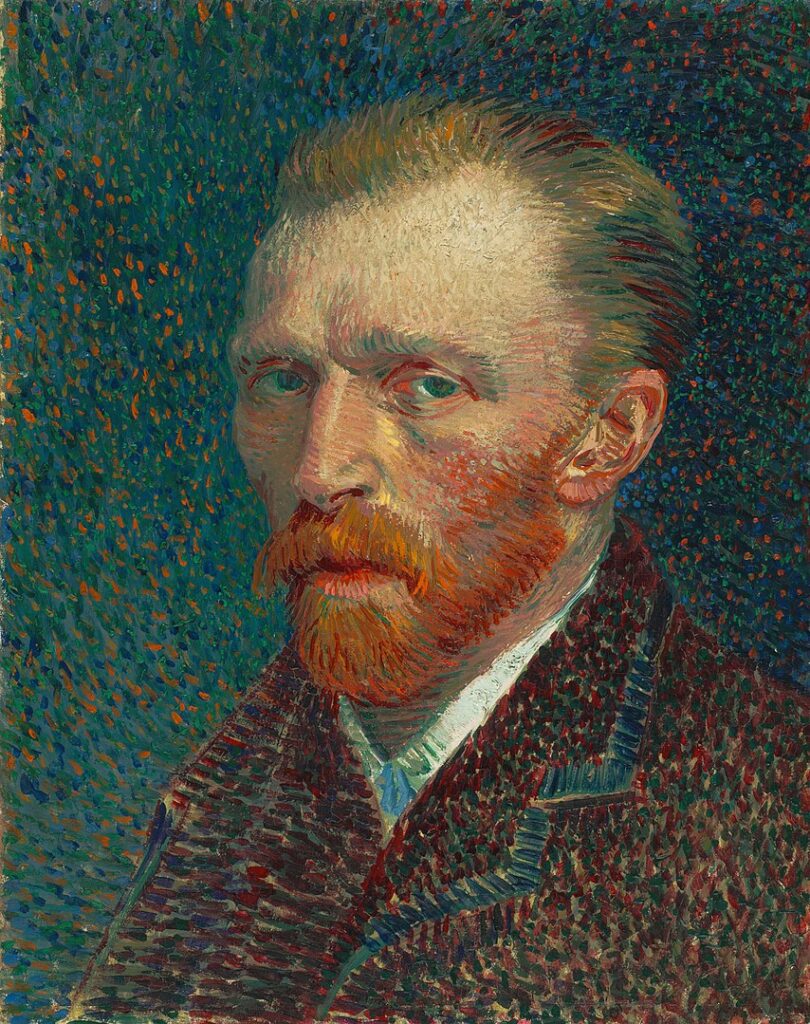
Pingback: 5 Reasons Why Artists Create Art and What Drives Their Creativity - Planet of Disobedients